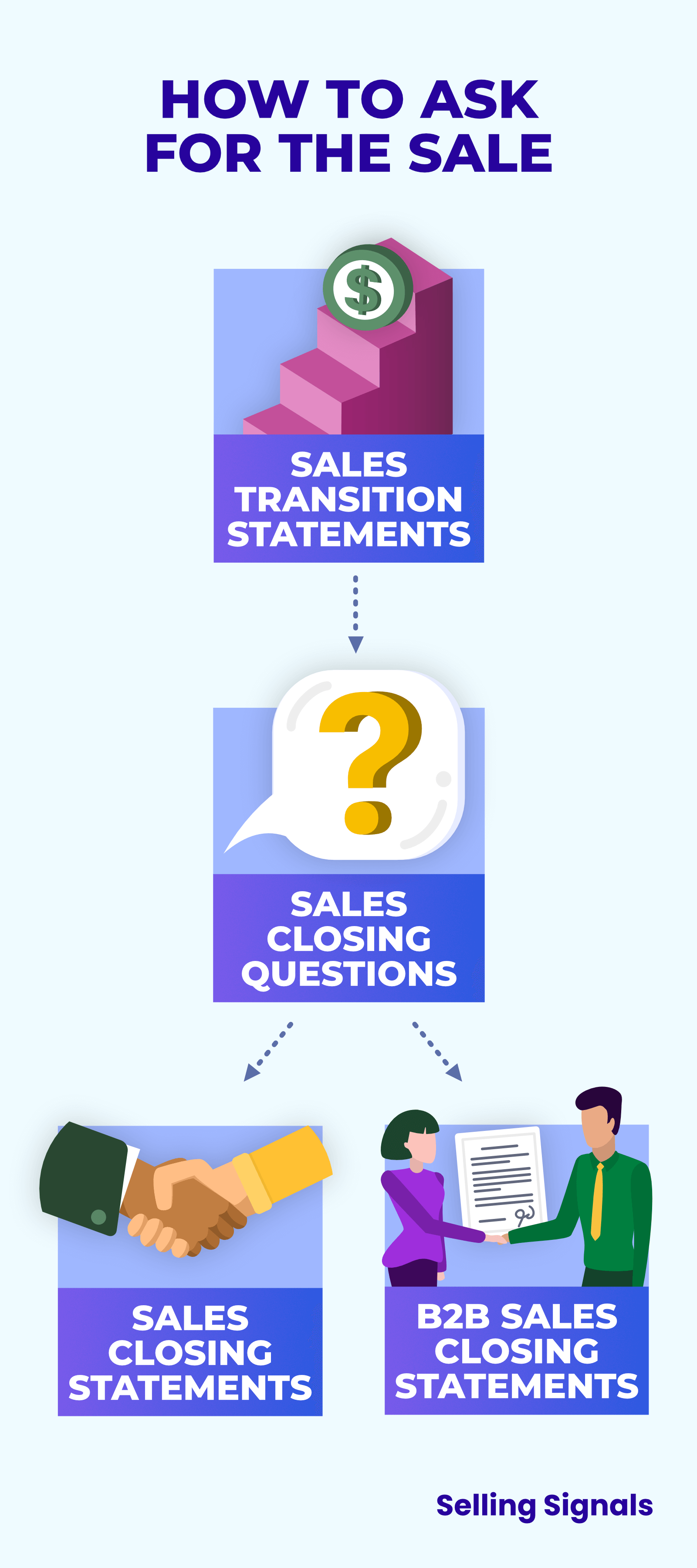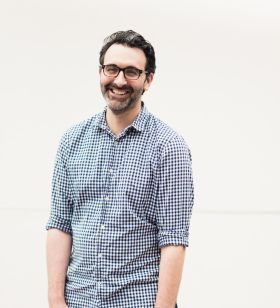-
News & Trends -
Sales -
Marketing Related Topics -
B2B Software Guides Related Topics -
Free Tools & Resources -
- About Us About Us
Closing questions and statements are phrases that help you officially ask a prospect for the sale. After nurturing a lead and telling them what to expect from a product or service, sales reps often recognize buying intent, then choose a personalized closing technique. Next, they use tailored questions and statements to move the prospect from the lead nurturing to the deal closing stage. If the buyer agrees to the sale, the rep sends a proposal and a contract to sign.
To make successful asks, use a transition statement, then key closing questions, then a general or B2B closing statement that matches your prospect:

Under each statement and question in this article, we've noted the best corresponding closing technique (such as the assumptive or summary close) to further help you tailor your strategy to each prospect. When you make the ask, also keep in mind the top tips listed underneath the statements and questions, which we've sourced from sales professionals who know they work.
Sales transition statements are phrases that start to progress the conversation from general negotiations to closing a deal. Setting the stage for a close in this way ensures that your prospect is open to finalizing the deal, which will increase the effectiveness of your closing statement later on. Consider first choosing a closing technique for your unique prospect and then using a related sales transition statement so your prospect is most likely to respond well.
Who Should Use It: Sales professionals looking to start the closing process with indecisive prospects who need a final nudge toward a purchase.
Corresponding Closing Technique: Assumptive close or option close
Salespeople who prefer an assumptive close — a closing technique that involves speaking in a way that assumes the prospect is going to buy the product — can use the “Let’s talk details” transition statement to lead into some assumptive delivery questions. By saying this phrase, you steer the conversation toward the logistics of delivery without asking them if they want to make a purchase.
The details you'll cover typically include the specific product they’d be purchasing, the number of units they’d buy, the options they’d like to add, when they’d like it delivered, and other key deal information. By diving straight into this conversation, you avoid giving them an opportunity to say they aren’t going to buy before you can try to close.
Who Should Use It: Sales professionals looking to provide specific justification for the close by pointing out the needs that the prospect has expressed to them.
Corresponding Closing Technique: Summary close
As opposed to jumping straight into delivery details, saying “Let’s go over what you’ve told me so far” transitions into a summary of the needs or objectives that the prospect has communicated to you throughout the discovery and negotiations processes. This is a straightforward way to tell the prospect why you believe that it’s time to close a deal.
Below are the details you can summarize when using this transition:
By providing this specific justification, you give your closing statement an overwhelmingly positive tone, as you’ve just recapped all of your prospect’s purchasing criteria and stated how your product meets them.
Who Should Use It: Sales professionals looking to remind the prospect that the product or service is a great fit for their needs and goals.
Corresponding Closing Technique: Summary close
If you want to communicate to the prospect that your product is the best solution for them, this is the transition phrase for you. Say, “It looks like our (Product) will work perfectly for you,” then follow up with two or three reasons why. These reasons will be related to the "Let's go over what you've told me so far" statement above. However, you’ll lead with what the product can offer the prospect and only bring up details that support that idea, so this requires less information from the prospect.
This transition technique is used to show how well you’ve listened, similar to the last transition phrase, but also adds a personal touch by further inserting the prospect into the verbiage. You’re not just saying that the product solves their problems or helps them achieve their goals, you’re saying that the product is perfect for them.
Once you've made the sales transition statement that you believe is the best fit for your prospect, it's time to move on to one or more sales closing questions, also tailored to your prospect.
Closing questions are the ones you ask to gauge your prospect's interest and decide how and when to make your closing statement. Typically, you’ll ask a couple of these questions after your transition statement, keeping in mind your prospect's personality and your chosen closing technique. If your prospect is resistant to making a deal, you can also use some of these questions to figure out what’s keeping them from moving forward.
Who Should Use It: Salespeople who want to make sure they uncover any possible roadblocks before promising a specific price from the prospect.
Corresponding Closing Technique: Soft close or sharp angle close
This question is also considered a soft close or a sharp angle close because you’re essentially asking the prospect if they’ll purchase under the condition that they get the stated price. You aren’t promising the price in question, you’re simply asking them if it’s really the primary factor, or if there are unrelated concerns that you'll have to overcome even if the price is right.
This is great to use if you’re almost sure that the price concession will get the deal done, and you want the prospect to commit to it. If they bring up another issue, then you’re one concern away from a deal. If they don’t, then all you need to do to close the deal is to get the price where they want it.
Who Should Use It: Sales professionals that are getting their prospect closer to buying by assuming they'll make a purchase.
Corresponding Closing Technique: Assumptive close
For assumptive closers, this is a great way to gauge your prospect’s interest in making a purchase before you directly ask for the sale. It assumes that your prospect has already decided they’re going to take your product home, and skips straight to when they need it delivered.
You’ll usually bring up this question after asking some softer delivery detail questions like “What color do you want?” or “What add-ons are you most interested in?” so that you’ve already gotten your prospect on the path toward the final close. Once you’ve asked a few of those initial assumptive closing questions, you’ll ask “When do you want to take it home?” before finishing with your closing statements and a direct ask.
Who Should Use It: Sales professionals that want to drive the sale by keeping the prospect’s focus on a beneficial professional relationship.
Corresponding Closing Technique: Inoffensive close or soft close
If you’re looking to lean into personal rapport with your prospect and develop a lasting consultative relationship with them, then leading your closing statement with this question is an effective way to state your intention. You simply ask them if they want your help (in other words, if they want you to be the one that solves their problem). This will uncover any potential concerns they may have about you and your company while also asserting that your goal is to help them.
Because this question is worded so carefully, it tends to work best with prospects that respond well to the soft close. It also works with aggressive prospects that require the inoffensive close, where you respectfully ask your prospect how they feel about the benefits your product will bring them.
Who Should Use It: Sales professionals that want to directly ask for the sale.
Corresponding Closing Technique: Any of the main closing techniques (assumptive, option, inoffensive, summary, sharp angle, soft, 1-to-10, puppy dog, urgency, take-away, or suggestive close)
Asking for the sale is the single most important closing question there is. Any variety of “Are you ready to purchase?” or “Can we make a deal?’ will suffice, as long as you’re directly asking your prospect to make a purchase. Every salesperson can improve their sales game simply by ending their negotiations with this direct ask — even those who have been using an assumptive close.
While some high-level salespeople are able to pull off an assumptive close without ever asking for the sale directly, the advice that will help the majority of sales professionals is to end any closing technique with a direct ask. So, this is the most crucial and versatile closing question on the list.
Who Should Use It: Sales professionals working with prospects who express that they aren’t ready to purchase.
Corresponding Closing Technique: Inoffensive close, summary close, sharp angle close, soft close, 1-to-10 close, or puppy dog close
When a prospect says they aren’t ready to purchase or objects to your moving forward assumptively, respond with this question. The goal is to work out exactly what’s holding them up so you know how to work the deal to get them back on track and then try an inoffensive, summary, sharp angle, soft, 1-to-10, or puppy dog close. This question will usually lead you into the objection handling phase, after which you can dive into your closing statements if you successfully rebut their objection.
If you want to better understand how to handle objections from a prospect, check out our guide on objection handling. There you’ll find tips and examples to help you get your prospects on board with your product, and respond thoughtfully to their concerns.
Your sales closing statement is the final phrase you say to ask for the sale. It drives home a sense of urgency and gives the prospect a reason to close now. The below are versatile and can be used in both B2C and B2B sales contexts. If you’re a B2B rep, we recommend you read this section and the next, then choose the statement that’s right for you and your prospect. However, you can head straight to the B2B statements section for more pointed B2B closing statements if you prefer.
Who Should Use It: Sales professionals who are confident that they’ve built a solid relationship and rapport with their prospect.
Corresponding Closing Technique: Assumptive close or summary close
If you’re getting along well with your prospect, pairing humor with confidence can go a long way in getting them to do business with you. By saying this at the end of your closing process, you reinforce that they’ve affirmed the validity of your product, confirmed that it will make their life easier, and gotten along with you. Once they’ve agreed with all of that, what reason is there for them not to buy?
Avoid this one if you have any major doubts about any portion of the closing statement. If you just got out of a hard battle over a product objection, then it may come off a bit arrogant to tell them they like the product. If they’ve been aggressive or demanding of you, or you’ve caused some abrasion in the conversation, then they might not appreciate your implying that they like you. This closing statement only works if you’ve built a strong relationship.
Who Should Use It: Sales professionals that have offered a limited-time discount or made significant concessions to your prospect.
Corresponding Closing Technique: Urgency close, sharp angle close, or soft close
When you offer a special deal to a prospect in a soft close or otherwise, leverage that concession to create urgency to close the deal. If you’ve agreed to a large discount, an extra add-on, or any other big ask from your prospect, tell them that you can only pull it off if you get the deal done right away. This gives a justified sense of urgency that’s framed as a benefit to the prospect.
This closing statement is unique in the sense that you can use it early on in the process, and it’s especially effective during the objection handling phase. By offering a concession on the condition that the deal gets finalized right away, you can give the prospect a reason to skip straight to the close and save you both a ton of time.
If you work in an industry with a long sales cycle, you can amend your deal to last 3–7 days. If you'd have to extend the offer any longer than a week, then you probably shouldn’t use this closing statement.
Who Should Use It: Sales professionals that want a safe, inoffensive closing statement for prospects with confrontational demeanors.
Corresponding Closing Technique: Inoffensive close
This closing statement is best used with prospects who are touchy, aggressive, or demanding. It offers them the opportunity to voice any concerns they have left, which will help prospects like this feel cared for and comfortable. Not only that, but this acts as their final chance to bring up these concerns; if they can’t think of any right away, the only other option is to move forward.
This statement is a good option because it doesn’t require any specific prerequisites, has little chance to come off as pushy or rude, and gives your prospect the opportunity to take the closing process at their own pace. The only downfall is the freedom that it gives your prospect to hold up the process or turn it around with never-ending concerns.
The above sales closing phrases are general enough to work well for both B2B and B2C businesses. However, if you represent a B2B company, you can choose one of these general sales closing statements or consider a more specific B2B closing statement below.
The following closing statements will operate in the same manner as those in the previous section, but these are specifically geared toward B2B sales contexts. They place less focus on the personal aspect of the sale, and more on the goal and problems of the business. The idea is to convince the prospect that you know exactly what their business needs, and that your product will get the job done and make them look good to their boss or team.
Who Should Use It: B2B sales professionals looking to leverage your prospect's deadlines to create a sense of urgency.
Corresponding Closing Technique: Urgency close or assumptive close
This closing statement is perfect for businesses that are shopping urgently and need your product (or one like it) fast. Not only does it show that you were listening to their needs throughout your discovery process, it also allows you to sell your product consultatively. This means that you come off as a trusted advisor who’s there to help them meet their deadline.
This comes up often in B2B contexts and works especially well when closing inbound B2B leads. Usually when a business owner or decision maker comes to you, there’s some level of urgency already present — this closing statement leverages it to get your deal done quickly. Whether the prospect is inbound or outbound, if a deadline has been mentioned, use it to your advantage and assume they'll want to close as soon as possible.
Who Should Use It: B2B sales professionals that have identified several value adds for their prospect, and want to create a sense of urgency through the time value of money.
Corresponding Closing Technique: Urgency close, assumptive close, or summary close
The time value of money refers to the idea that a dollar today is worth more than a dollar tomorrow, or that the sooner you invest in something that saves or generates time or money, the more worthwhile the investment becomes. By assuming they'll close and summarizing exactly what they'll get out of your product, you can illustrate how pulling the trigger sooner will improve the outcome of the investment.
So, if you’ve discovered that your product will offer the prospect several benefits that scale over time, this closing statement is the perfect option. This is another closing statement that opens up a consultative approach, as you’re simply laying out a way for them to maximize profit from an investment they’re already interested in making.
If you can, show them the value they’d lose by waiting a month. Calculate how much time or money your product would save or generate for them over the first month, and tell them exactly what they’re missing out on if they decide not to pull the trigger right away.
Who Should Use It: B2B sales professionals that are dealing with more confrontational or aggressive prospects, or are looking for a safe “default” option.
Corresponding Closing Technique: Inoffensive close or urgency close
Similar to the last phrase in the general closing statements section, this statement is meant to be as inoffensive and versatile as possible. It offers the least potential for abrasion and focuses on making the prospect feel comfortable and cared for. By stressing their busy schedule, you’re respecting their position as a business owner or decision maker and using a bit of flattery to help create a sense of urgency.
Although custom-tailored statements are often the most successful, as they allow you to present yourself as a helpful consultant, inoffensive statements such as this one are the best default options. Use them when you don’t have enough information for a custom statement — they can still be highly effective and work for the widest variety of prospects.
Who Should Use It: Sales professionals that want to create a sense of urgency by offering a “once in a lifetime” deal to a prospect, making it clear that today is the only day it can happen.
Corresponding Closing Technique: Urgency close, take-away close, sharp angle close, or soft close
This is a common closing phrase that offers a great price to the prospect under the condition that a deal gets done right then and there. You have to ensure that the price is better than what they’ll find on your website or with a promotion that you commonly offer. Give them a strong enough incentive and a strict deadline, and this closing statement can help you get the deal done that day.
You can choose a closing technique that fits your prospect and then match your statements and questions to the technique, or you can simply choose the statements and questions that seem best for your unique prospect. Either way, you should find success if you use a sales transition statement, then a sales closing question, then one of the two types of sales closing phrases. In time, this process will seem more natural and you'll come off as a more confident, expert-level seller.
As you plan and execute your transition statements, closing questions, and closing statements, there are a few tips you should keep in mind to increase your chances of receiving a positive response from each prospect. Read on to see how experienced sales pros prepare to ask for the sale, as well as how and when they make the ask within their sales process.


Founder & CEO, HostPapa
"When your lead says 'yes,' you should be prepared to provide them with a proposal and a contract. But not just any suggestion will suffice. Your product or service and any specific packages or levels should be a perfect fit for them, which involves being a good listener throughout your relationship."
— Jamie Opalchuk, HostPapa


Founder & E-commerce Strategy Lead, FirstPier
"Filler words are conversation killers — these verbal crutches are insidious since you may not even realize you're using them. Overuse of fillers such as 'you know,' 'uh,' and even 'honestly' may impede your consumer from hearing your actual message. Using pauses instead of fillers in your speech will make you sound more professional and informed, which may encourage your prospect to pay more attention."
— Steve Pogson, FirstPier


Director, Considered Content
"The timing component is one of the factors that may make you worried about whether your prospect will say 'yes.' Is it even appropriate to raise the issue at this point? Is it possible to spoil your chances for good if you jump the gun? You must ensure that you are prepared to move forward with confidence. It's unlikely to win you a 'yes' right away, but it won't damage your chances of closing the deal. What you should be worried about is asking the question too late. The more time you allow a prospect to think about what you've been talking about, the more time they'll have to evaluate different options."
— Jason Ball, Considered Content


Chief Marketing Officer, Expandi
"When you ask a prospect for the sale, there are certain words you don't want to say. As an experienced salesperson, I know a few words that may seem innocuous but are powerful enough to make a potential customer call the deal off:
- Cheap. This word takes value away from your product/service. Instead, say it's affordable.
- Adverbs of probability such as maybe, perhaps, probably, possibly, etc. These denote a lack of confidence. If you don't know the answer to their question, be honest and say you'll give them an answer as soon as you have it.
- Competition. Bringing up and lowering the competition is a deal-breaker for most people, so focus on the good things you have to offer and not the 'bad' things from others.
- Obviously. This word can make prospects think you're doubting their intelligence, which they could take as a personal attack."
— Sharon Van Donkelaar, Expandi
No matter how much or how little detail you have on your prospects, there is almost always a route to nurture them to deal-close. If you have a lot of information on your prospect, use the examples of closing statements and questions that lean on the details they’ve shared with you and seem to fit their personality. If not, pick the options that lead with the benefits of the product. Consider using at least one question or statement from each section to create your asking script.
Trey is a former salesperson and current Orange County-based tech, sales, and finance writer. His specialties include sales guides, personal finance articles, and reviews across financial and credit products. In his free time, Trey writes fiction and practices boxing and Brazilian jiu-jitsu.

Selling Signals delivers actionable advice for sales and marketing professionals. Learn strategies that help you hit targets, strengthen customer relationships, and win more business. Get expert advice on lead generation, sales processes, CRM software, sales management, and account management directly to your inbox.
Property of TechnologyAdvice. © 2026 TechnologyAdvice. All Rights Reserved
Advertiser Disclosure: Some of the products that appear on this site are from companies from which TechnologyAdvice receives compensation. This compensation may impact how and where products appear on this site including, for example, the order in which they appear. TechnologyAdvice does not include all companies or all types of products available in the marketplace.